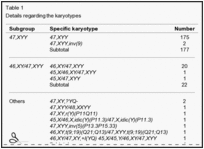2011 Group Project 3
| Note - This page is an undergraduate science embryology student group project 2011. |
Kleinfelter Syndrome
Introduction
Klinefelter's syndrome is a condition wherein a male has an extra X chromosome. Typically, women and men have two sex chromosomes, women have two X chromosomes (46,XX), while men have an X and Y chromosome (46,XY). '46' refers to the total number of chromosomes present including both autosomes and sex chromosomes. However, men with Klinefelter's syndrome have three sex chromosomes (47,XXY) due to a process known as non-disjunction.
This usually presents with a few standard clinical abnormalities. Affected men can can have reduced fertility and hypogonadism. However, a high proportion of affected men may not show any symptoms and the severity of the disorder differs greatly from person to person. It is thought to be one of the most common conditions caused by disjunction.
History
Epidemiology
--z3289991 10:15, 13 August 2011 (EST)
Signs and Symptoms
Etiology
Pathogenesis
Other Similar Defects
Recent Research
Glossary
References
2011 Projects: Turner Syndrome | DiGeorge Syndrome | Klinefelter's Syndrome | Huntington's Disease | Fragile X Syndrome | Tetralogy of Fallot | Angelman Syndrome | Friedreich's Ataxia | Williams-Beuren Syndrome | Duchenne Muscular Dystrolphy | Cleft Palate and Lip
